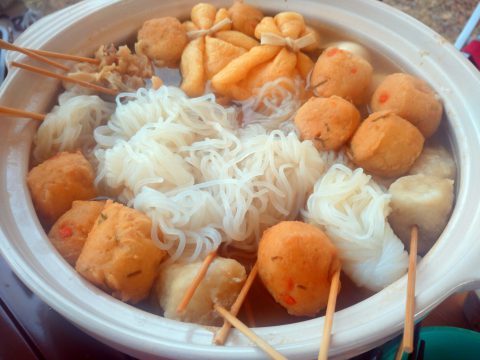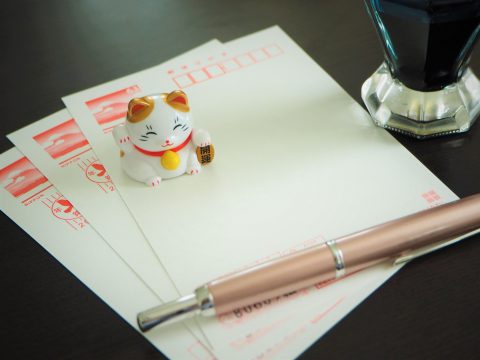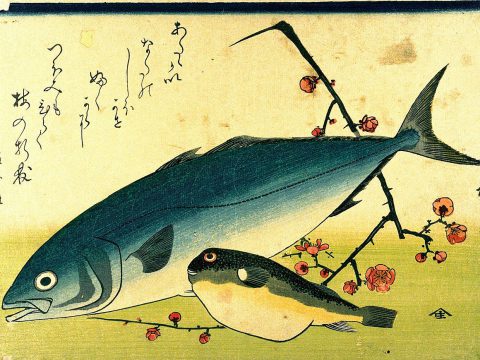Shirako(白子)
JAPANESE FOODS
12.07.2022
Shirako (白子, “white child”) is fish’s milt, or sperm sacs. The Japanese eat the milt of cod, anglerfish, blowfish, and salmon. It’s eaten raw and cooked and is considered a delicacy in Japan. It has a milky, creamy, velvety texture, similar to oysters or runny cream cheese. It’s also seasonal and can only be found during the winter months of December to February, reaching peak flavor in January.
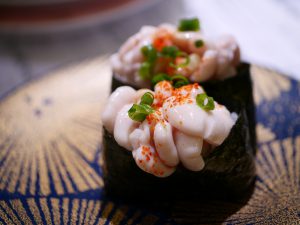
Milt is also eaten in other parts of the world and is not just a specialty of Japan. Like ikura (salmon roe) and uni (sea urchin gonads), it’s an acquired taste but is high in protein and vitamin B12 and low in fat and carbohydrates. It’s believed to be good for the skin and has anti-aging properties.
Ready to explore shirako? Here are some of the ways you can try shirako.
Shirako ponzu (白子ポン酢)
The most traditional and straightforward way of trying shirako is raw shirako drizzled with ponzu (a citrusy and umami-rich soy sauce). It may include wakame seaweed, grated daikon, finely chopped scallions, or shiso leaves. You may find this dish served at Japanese restaurants and sushi shops.

Shirako gunkan (白子軍艦)
Shirako is also eaten as sushi. As it can get messy, it’s usually served like ikura sushi; a mound of sushi wrapped in nori seaweed with the shirako on top. This style of sushi is called gunkan-maki (軍艦巻き, “battleship roll”).

Shirako yaki (白子焼き)
Try grilled shirako, which intensifies the creamy and pudding-like texture with an added charcoal flavor.
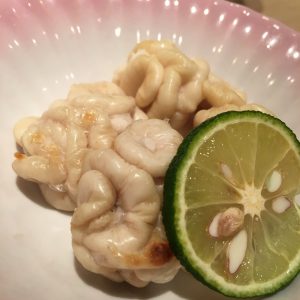
Shirako tempura (白子天ぷら)
Try shirako tempura, where the exterior is light and crunchy from deep-frying, but the inside retains that creaminess. Eat with salt or tsuyu (つゆ, umami-rich dipping sauce).

Shirako chawanmushi (白子茶碗蒸し)
Chawanmushi refers to savory steamed egg custard featuring chopped vegetables and protein. It’s eaten at both high-end restaurants and home. You can add shirako into the chawanmushi mixture before steaming it.
Shirako and cod hot pot (鱈ちり鍋)
A bit morbid if you think of it as a father-son collab, but this is a winter-only hot pot featuring cod, shirako, and other veggies in a light broth. In Japanese, this hot pot is called tara-chiri-nabe (chiri-nabe ちり鍋 refers to a hot pot with white fish, tofu, and vegetables).


Kayoko Hirata Paku
Kayoko Hirata Paku is a food writer, translator, and bagel person. Growing up in Japan and the U.S., she currently resides in Tokyo with her peanut butter addicted husband, a very hungry baby, and many half-dead plants.
Read previous articles by the writer
Read latest articles
KEYWORDS
- # PICKPICK
- # Resume
- # alcohol
- # Rice
- # Soup
- # winter food
- # Fast Food
- # seafood
- # spicy foods
- # raw food
- # fermented food
- # Transportation
- # MEAT
- # Edo culture
- # suits
- # clothing
- # drink
- # fish
- # seasoning
- # Japanese New Years Foods
- # Toshikoshi soba
- # Osechi Ryori
- # Ozoni
- # Christmas
- # Japanese fusion pasta
- # Wafu Pasta
- # Japanese Hot Pot
- # なべ
- # 鍋
- # Miyazaki
- # Chicken Nanban
- # Karamen
- # Autumn Wagashi
- # Mushi-yokan
- # Imo-yokan
- # Japanese Autumn Fruits
- # Autumn
- # Vending Machine
- # fall
- # dango
- # Chestnut rice
- # saury
- # Mushroom
- # Rice vinegar
- # Japanese condiments
- # 調味料
- # Sake
- # Mirin
- # Soy sauce
- # Japanese Noodles
- # Udon
- # Ramen
- # Yakisoba
- # Soba
- # Japanese Seaweed
- # 海藻
- # かいそう
- # Payslip
- # Training
- # Japanese summer foods
- # 和菓子
- # Wagashi
- # ryokucha
- # 夏
- # 飲み物
- # Ramune
- # ラムネ
- # Pokari Sweat
- # ポカリスエット
- # Calpis
- # カルピス
- # Mugicha
- # ume
- # 梅
- # うめ
- # umeshu
- # job hunting
- # tofu
- # Recruitment in Japan
- # miso
- # Japanese cuisine
- # Yellowtail and bonito
- # Children’s Day
- # Kashiwa Mochi
- # Chimaki
- # fruits
- # Kusamochi
- # Types of Agriculture in Japan
- # bread
- # パン
- # パン屋さん
- # japanese bread
- # shokupan
- # meal blead
- # anko bread
- # 桜
- # さくら
- # cherry blossom
- # visa
- # hanami
- # omotenashi
- # sakura
- # おもてなし
- # Japanese hospitality
- # oshibori
- # wet hand towel
- # hand towel
- # restaurant
- # Commuting in Japan
- # Women-only cars
- # Exit gate
- # japanese train
- # train
- # valentine
- # Japanese sweets
- # 朝食
- # Japanese Breakfast
- # Breakfast
- # Japanese
- # 日本
- # healthy
- # persimmons
- # hoshigaki
- # HR
- # work in Japan
- # jinji ido
- # corporate systems
- # Japanese work culture
- # bento
- # ekiben
- # shinkansen
- # omiyage
- # train station
- # Japanese culture
- # work culture
- # mentaiko
- # umeboshi
- # Japanese snacks
- # potato chips
- # Japanese potato chips
- # Japanese writing
- # seaweed
- # konbu
- # ocean foods
- # shio konbu
- # dashi
- # miso soup
- # food processing
- # pear
- # nashi
- # sweet potato
- # japanese sweet potato
- # stingray
- # satsuma imo
- # food value chain
- # homecooking
- # agriculture
- # Japanese homecooking
- # farming
- # nikujaga
- # shojin ryori
- # meat and potatoes
- # traditional foods
- # comfort food
- # buddhist food
- # manufacturing
- # factory
- # eihire
- # vegetarian
- # food and beverage
- # izakaya
- # yatai
- # japanese festival
- # taiyaki
- # matsuri
- # summer
- # Ikayaki
- # smart agriculture
- # shaved ice
- # kakigori
- # かき氷
- # summer dessert
- # Japan
- # Japanese foods
- # dessert
- # fruit
- # matcha
- # icecream
- # Pikcup
- # Pikc up
- # Pcikup
- # skilled labor visa
- # working visa japan
- # Dineer Table in Japan
- # Japanese manner
- # Japanese food
- # Japanese Table Manner
- # Chopsticks
- # Japanese traffic signs
- # traffic information
- # road rules in Japan
- # chocolate
- # green tea
- # Osaka
- # Work Japan
- # Japanese company
- # ikura
- # sushi
- # nigiri
- # wasabi
- # PCIK
- # PICK UP
- # PICK
- # PICKUP


